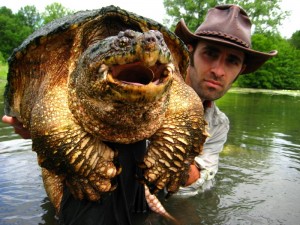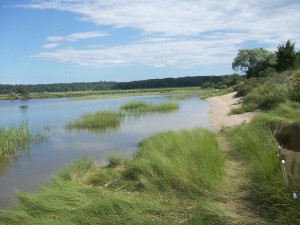 The incredible diversity of life in tidal creeks and rivers has attracted me since childhood. And while invertebrates and fishes predominate, areas where fresh and salt water meet hold wonderful surprises for reptile enthusiasts as well. Today I’d like to discuss a turtle that I often find in brackish water habitats, and which seems to be evolving unique adaptations to survive there – the Snapping Turtle, Chelydra serpentina.
The incredible diversity of life in tidal creeks and rivers has attracted me since childhood. And while invertebrates and fishes predominate, areas where fresh and salt water meet hold wonderful surprises for reptile enthusiasts as well. Today I’d like to discuss a turtle that I often find in brackish water habitats, and which seems to be evolving unique adaptations to survive there – the Snapping Turtle, Chelydra serpentina.
A Turtle Banquet
The Long Island (NY) tidal creeks (please see photo) that I frequent seem “paved” with crabs, marine worms, snails, bottom fishes, mussels, clams, shrimp and other foods that could be easily exploited by turtles. In fact, research indicates that at least one marine turtle, the Kemp’s Ridley, actively migrates to the LI Sound, gaining up to a pound per week during the time it remains there. The Snapping Turtles I’ve seen in such habitats have been quite large, and I can’t help but think that abundance of high quality, easily-caught food must play a role in their presence.
I’ve even been fortunate enough to come upon a family of River Otters in one tidal creek, a species long gone from LI but now making a comeback. I’ve worked with captive otters, and can attest that if they are present, there’s lots of food about – their appetites are unbelievable!
Of course, Snappers confined to freshwater get quite large also. The fellow shown in this article weighs in at 70-80 pounds (the other turtle is a 206 pound Alligator Snapping Turtle, a relative) and the behemoth pictured here (held by Brave Wilderness’ Coyote Peterson) tipped the scales at about 55 pounds.
Freshwater Turtles in Brackish Environments
I’ve observed Snappers in most of my favorite tidal creeks, some of which are also home to Diamondback Terrapins. The occasional Eastern Mud Turtle has also shown up (it seems that, in southern NYS, Mud Turtles are confined to tidal streams on Long andStatenIslands), along with Red-Eared Sliders and, once, a hatchling Eastern Painted Turtle. While Diamondbacks have well-known adaptations to brackish habitats, I wondered about the other species, all of which typically live in fresh water.
Snappers’ Adaptations to Brackish Water
 I thought back to a study of Snapping Turtles living in the tidal reaches of the Carmen’s River, which I had read some 20 years ago. Casting about, I found it, along with another…but not much else seems to have been written on the topic (please see abstracts below). I learned that certain Snapper populations are indeed developing strategies to cope with life in salt water. In one experiment, hatchlings from nests near tidal creeks grew faster in 10-35% sea water than they did in fresh water. They also fared better in this water than did Snappers collected in fresh water habitats. When kept in fresh water, snappers originating in fresh water habitats grew faster than those from the brackish portion of the same river.
I thought back to a study of Snapping Turtles living in the tidal reaches of the Carmen’s River, which I had read some 20 years ago. Casting about, I found it, along with another…but not much else seems to have been written on the topic (please see abstracts below). I learned that certain Snapper populations are indeed developing strategies to cope with life in salt water. In one experiment, hatchlings from nests near tidal creeks grew faster in 10-35% sea water than they did in fresh water. They also fared better in this water than did Snappers collected in fresh water habitats. When kept in fresh water, snappers originating in fresh water habitats grew faster than those from the brackish portion of the same river.
Snapping Turtles that frequent tidal regions have not, however, completely severed their ties with fresh water. Hatchlings are unable to cope with environments comprised of over 41% seawater. Adults are more tolerant than smaller individuals, but lose body water and suffer increased internal osmotic pressure if confined to highly saline water.
Estuary-dwelling Snapping Turtles are believed to represent an early stage in the adaptation to marine environments. They lack the Diamondback’s Lachrymal Gland, which secretes salt (hatchling Diamondback Terrapins do well at concentrations of up to 64% salt water), yet the fact that their young grow best in brackish water indicates that some physiological changes may have occurred.
Field research has shown that Snappers primarily rely upon behavior to regulate their exposure to salt water, moving from creek mouths to fresher waters further upstream as needed. In addition to salt-excreting glands, Diamondback Terrapins also utilize behavior to modify salt intake. Unlike Snappers, they leave the water for land when necessary, and may also swim into fresh water.
Other Reptiles
Eastern Mud Turtles and other species that enter brackish water may use strategies similar to those employed by Snappers, but further research is needed. Reptiles such as Salt Marsh Snakes and American Crocodiles have also adapted somewhat to brackish water, moving between estuaries and fresh water in order to drink and moderate the internal effects of salt water exposure.
Sea snakes, sea turtles and the Marine Iguana have taken salt-excretion and other adaptations further even than the Diamondback Terrapin, and are true marine creatures in every sense of the word
Salt Water Amphibians?
Amphibians are notably absent from estuarine environments. Amazingly, however, the Mangrove or Crab-Eating Frog, Rana (Fejervarya) cancrivora, is quite tolerant of saline waters. I’ve always considered this frog to be a quite special creature, but recently came across a note that it is “commercially raised as food for predatory pet fish” in Singapore (please see link below)…quite surprising!
American Toads have been documented as breeding in brackish water, and I’ve found Fowler’s and Spadefoot Toad tadpoles in ponds that would likely be exposed to salt water on occasion (please see this article for photos of a coastal pond in which I’ve found Red-Eared Sliders and Fowler’s Toad tadpoles) . Also, a feral population of African Clawed Frogs occupies slightly brackish pondsin England.
Salt-tolerant amphibians fascinate me…any observations you might be able to share would be most appreciated, please write in.
Further Reading
Snapping Turtle Growth Study (Brackish Water)
Snappers in the Carmen’s River Estuary
Osmoregulation in Crocodilians
 That Reptile Blog – Reptile, Amphibian and Exotic Pet Care and Information
That Reptile Blog – Reptile, Amphibian and Exotic Pet Care and Information



Frank
Once again great article will keep coming back for more
Thanks for the kind words, Daniel; following you on Twitter also. Let me know if you need any articles on turtle care or natural history, Best, Frank
I enjoyed your article on fresh water turtles adapting to brackish. Diamond back terrapin eggs were not far from from snapping turtle nests at 100 Acre Cove on the Barrington (RI) and Swansea (Mass) border. Have seen many snappers in brackish, some in real salt.. Goosewing beach, near Westport, Mass is known for the abundance of toads very close to the actual ocean.. Haven’t seen the musk in brackish yet. They are tough though.. I look forward to reading more of your work.
Hello Bud,
Thank you for the kind words and interesting observations…much appreciated. Very interesting to hear of the snappers in marine water…those in tidal creeks on Long Island seem to stay around at high tide as well, at sites close enough to the mouth that it would seem to be pure salt water…but many folks doubt me, so I’m glad to have your note! Enjoy and pl keep me posted, frank